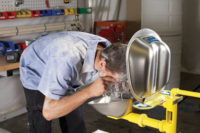Enclosures provide plenty
When enclosures are used indoors to house emergency shower and eyewash equipment, they help to contain the water, provide protection to surrounding equipment, and contribute to the proper waste and disposal of the water. For the user, they provide privacy when utilized with a curtain or door, helping to encourage the full 15-minute decontamination and the removal of any contaminated clothing. Visibility of the drenching location and area is also enhanced, providing the hallway, room, or laboratory with a defined focal location for the equipment.When enclosures are used outdoors, they offer the same advantages of water containment and waste, user privacy, and visibility. Additionally, outdoor enclosures protect the user against inclement weather, which encourages complete drenching. Outdoor enclosures also protect the emergency equipment from long-term exposure to the sun, wind, dust, and rain.
Assessing your needs
If you’re designing an indoor emergency equipment station that includes the use of a drench shower enclosure, you’ll want to choose materials that will withstand the corrosive atmosphere in your environment.In a clean room laboratory environment, for example, you want a material that does not particulate or become corrosive.
Enclosures are found to include many types of emergency equipment. Showers, face-washes, eyewashes, drench hoses, and tempering units are available as standard or optional equipment that can be housed in these booths. The level of protection desired for the user or the surrounding environment might cause you to consider an enclosure with a self-closing door, privacy curtain, or accordion door. Graphics and signage should also be included on the sidewalls of these utility buildings when the requirements do not ask for it to be fully recessed into a wall system.
In outdoor applications, attention to corrosive elements in the air and UV protection are a concern. You might want to require that the outdoor booth chosen is weather resistant and insulated. Insulated booths are currently available with R values that range between nine and eleven.
Again, the choice of emergency outdoor enclosures can include any combination of showers, eyewashes, face-washes, drench hoses, or tempering units. Consideration must be given to any freeze protection of the equipment that may be desired. Freeze protection can be accomplished through heat tracing, freeze bleed valves, or interior space heaters. Any of the three are available and can be specified. It is strongly recommended that for any outdoor applications, self-closing doors be included as a standard feature, and that visible, user-friendly graphics be included on all sides of the outdoor utility room.
Enclosure options
Enclosures come in a variety of shapes and sizes, but most are between 3 ft. by 3 ft. and 4 ft. by 5 ft. in overall width and depth, and exhibit heights between 88 and 102 in.Enclosures constructed from fiberglass shells are best-suited for indoor environments. They offer an economic alternative to other materials and designs and provide the privacy and water containment features desired. These types of enclosures, however, are not suitable for most clean room applications.
Stainless steel enclosures are best suited for highly corrosive environments or any clean room applications. They are primarily suited for indoor applications since they do not come with insulation. As with other emergency shower booths, they provide excellent water containment and user privacy advantages.
Polyethylene molded booths are available with insulation and UV protection. They can handle both indoor and outdoor environments. In most cases, the material is compatible with clean rooms. Molded polyethylene booths come with or without doors and can offer a substantial level of privacy and water containment.
For outdoor environments with extreme climate conditions, the insulated fiberglass booths offer excellent insulating and weather-resistant characteristics. They are typically provided with insulated bump-through doors and are often heated internally. Their ability to provide user privacy, water containment, and equipment protection is excellent.
Additional considerations
When designing your emergency drench shower and eyewash enclosures, you might need to address these issues:- Local and remote alarming is available through flow switch or proximity switch activation.
Alarms can be activated by the use of the shower or eyewash and can cause an exterior light to flash or an audible alarm to sound.
- Space heaters are also available for heating the outdoor enclosure through forced air or convection-type electric heaters.
- Interior lights may also be required for any outdoor or after-hours applications.
- Most emergency utility booths come with some bracketing or hold-down feature. Manufacturers can also address any high wind or seismic criteria you may require.
- Providing tempered water to emergency fixtures is a popular requirement. Manufacturers have tempering systems available that warm the incoming water to between 60 and 95 degrees for use with indoor or outdoor booths. Outdoor tempering units also come housed within outdoor enclosures to provide onsite remote tempering of emergency shower and eyewash supplies. These tempering booths may be linked to a number of other outdoor or indoor shower and eyewash enclosures. A tempering system that might be housed in an enclosure is typically made up of blending units (thermostatic tempering valves) and a hot water tank or instantaneous steam heater.
Whatever your application, emergency equipment enclosures provide the designer, owner, and user with answers to a number of needs. Water containment and drainage, protection of the equipment, and the privacy and protection of the user cannot be understated when deciding to specify an enclosure. Your environment, location, and economics will play a key role in choosing the right enclosure for your needs.

